Cover image of Jackal Buzzard by Gregg Darling – Near St. Francis Bay, Eastern Cape – BirdPix No. 8247
Buzzards belong to the Family ACCIPITRIDAE along with Eagles, Kites, Vultures and Hawks etc. They are mostly medium to very large birds with females usually being larger than males. They have relatively short, strongly hooked bills and powerful legs and feet with strong claws.
Identification
The Jackal Buzzard is a fairly large, stocky and conspicuous raptor. The sexes are alike in terms of plumage coloration but females are distinctly larger than males. Females can weigh up to 1.6 kg with males weighing up to 1.08 kg (average 960g). Jackal Buzzards can attain a wingspan of 1.44 m.

Addo Elephant National Park, Eastern Cape
Photo by Desire Darling
All adult birds have have blackish-grey upperparts and a blackish head with scattered fine, pale streaks. The rump and upper tail coverts are black. The upper tail is rufous, and often (but not always) with a black terminal band.
The colour of the underparts is variable with 3 basic colour forms. There is an uncommon white-breasted Morph with a white breast and sometimes also a white belly. A rare dark morph can also be found with almost completely black underparts. The vast majority of individuals have rufous breasts, separated from the blackish head by an untidy white band. The rest of the underparts are dark grey with variable white mottling.
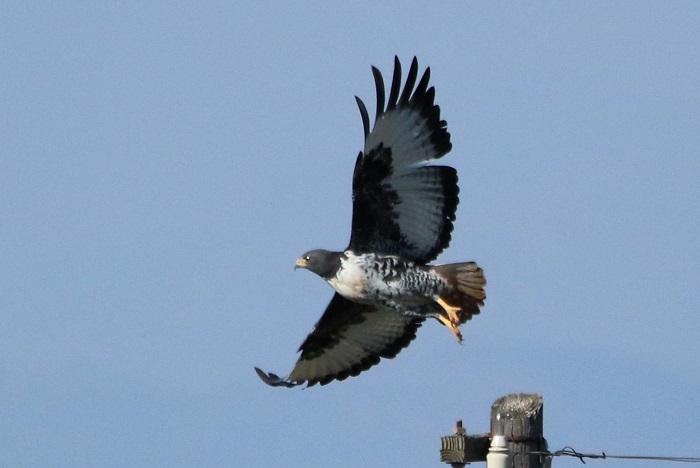
Oudtshoorn district, Western Cape
Photo by Attie van Aarde
In flight the Jackal Buzzard is characteristically Broad winged. When seen in flight from below, the adult Jackal Buzzard shows white flight feathers with black tips forming a broad black terminal band. The underwing coverts are black. All colour forms have pale rufous under tail feathers. The bill is dark grey, the eyes are brown and the legs, feet and cere are yellow.
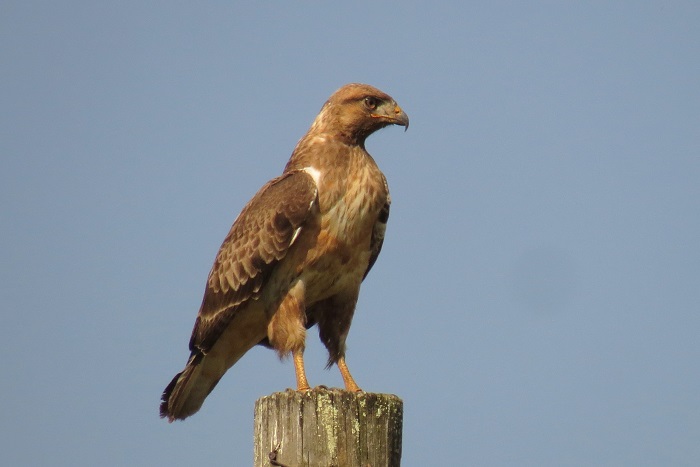
Underberg district, KwaZulu-Natal
Photo by Pamela Kleiman
Young birds start off in juvenile plumage with rich brown heads and upperparts while the underparts are either plain rufous, buff or whitish, with darker central streaks. Juvenile birds have longer tails than the adults.
Slightly older immature birds show a patchy combination of juvenile and adult plumage. They also have bright rufous central upper tail feathers. Adult plumage is acquired at 2 to 3 years of age.
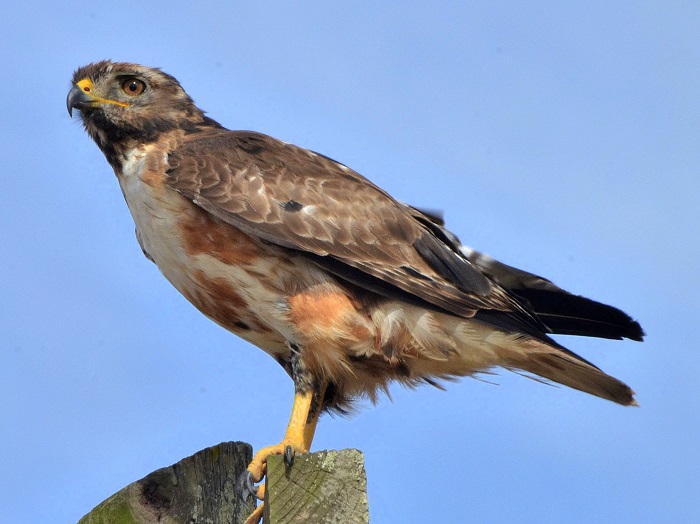
St. Helena Bay, Western Cape
Photo by John Todd
Typical form adults are distinctively plumaged and not likely to be mistaken for another species. However, in flight they can be confused with the Bateleur (Terathopius ecaudatus) but that species is much larger and shorter tailed with a distinctive flight profile. White-breasted morph Jackal Buzzards are frequently mistaken for the Augur Buzzard (Buteo augur), which is a closely related species. The Augur Buzzard differs from most white-breasted Jackal Buzzards in having white (not black) underwing coverts, and a white (not dark grey) belly and thighs.
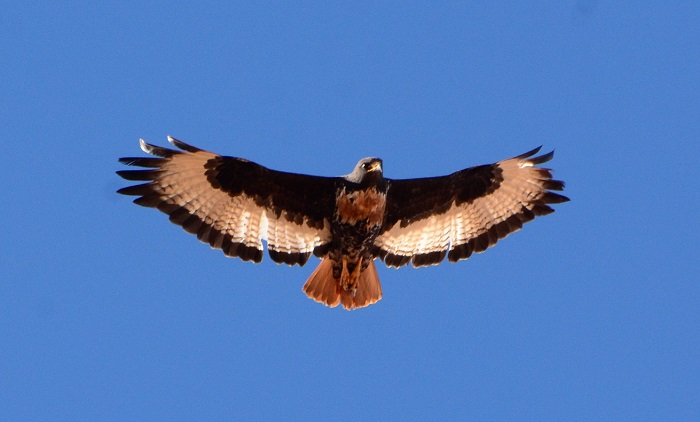
Carnarvon district, Northern Cape
Photo by Ryan Tippett
Juvenile Jackal Buzzards are more problematic to identify. They can be mistaken for juvenile Augur Buzzard but that species is usually paler with creamy brown underparts and with more extensive barring on the underwings and tail. Additionally, both adult and juvenile Augur Buzzards show a black carpal comma on the underwing.
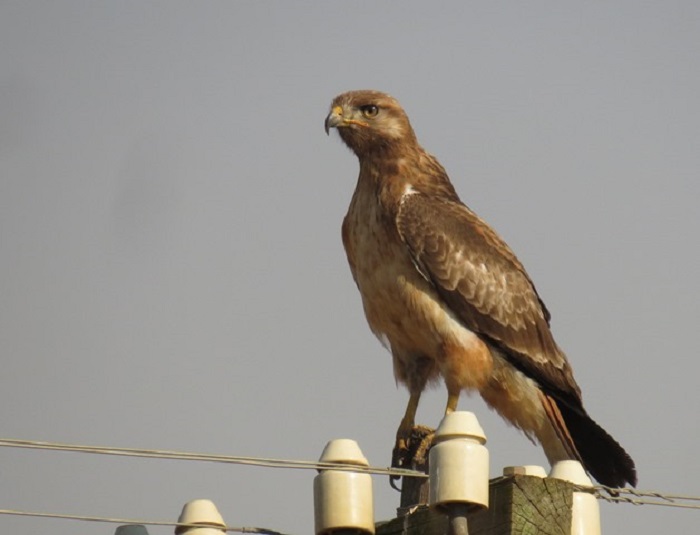
Himeville, KwaZulu-Natal
Photo by Pamela Kleiman
Jackal Buzzard juveniles can also be mistaken for Common Buzzard (Buteo buteo), but the latter is smaller and with proportionally longer, narrower wings. The Common Buzzard also has blotched or barred underparts and the underwing coverts are usually streaked or barred dark brown.
Status and Distribution
The Jackal Buzzard is endemic to Southern Africa where it is a fairly common resident.
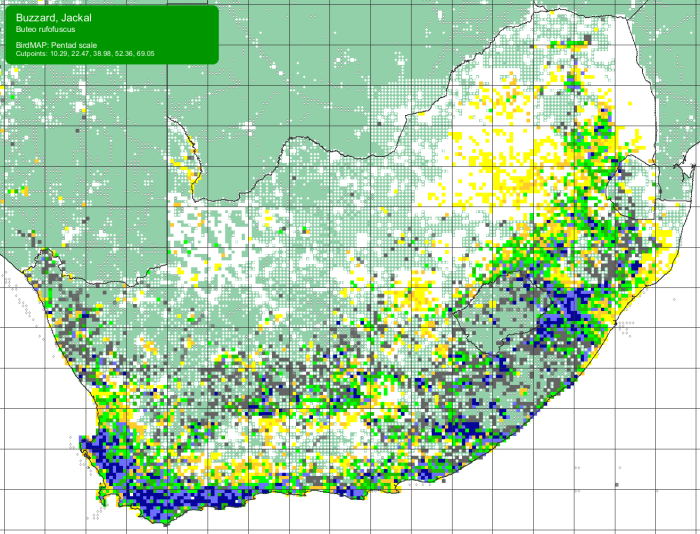
The Jackal Buzzard is widespread across South Africa but is is patchily distributed in the north-central region and absent from most of the north-eastern lowveld and the low-lying plains of the ‘Great Karoo’. The Jackal Buzzard’s main strongholds are in the Eastern Cape Province, Lesotho and the Drakensberg and Midlands regions of KwaZulu-Natal. It is also numerous in the central and north-western Karoo, and along the south-eastern and southern littoral. The Jackal Buzzard is marginal in south-eastern Botswana, Zimbabwe and extreme southern Mozambique.
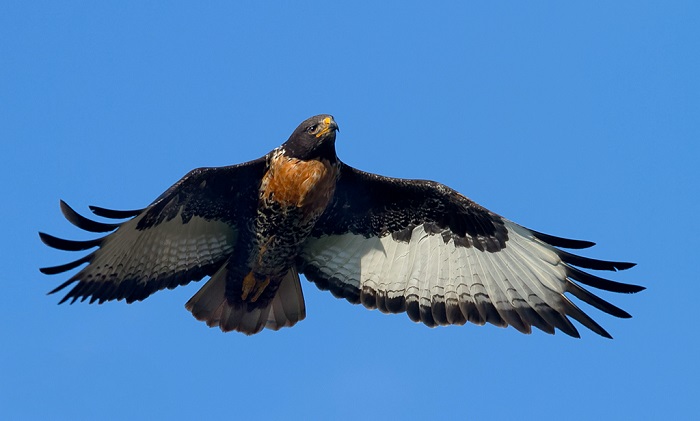
Near St. Francis Bay, Eastern Cape
Photo by Gregg Darling
There is no evidence to suggest that either the distribution or overall numbers have changed in historical times. The Jackal Buzzard remains common, even where large scale afforestation has occurred. The Jackal Buzzard is not considered threatened
Habitat
The Jackal Buzzard prefers mountainous and hilly terrain, especially where covered by short vegetation like grassland, Karoo scrub or fynbos. It also occurs in open woodland in hilly areas and arid coastal habitats in Namibia.
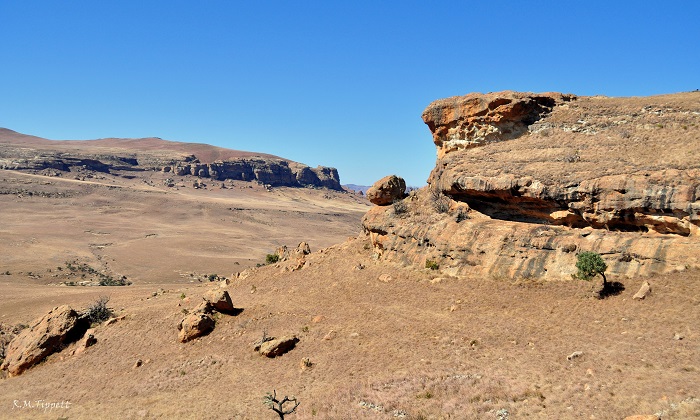
Golden Gate Highlands National Park, Free State
Photo by Ryan Tippett
Non-breeding birds and juveniles often wander seasonally into flat regions. The majority of nest sites are on cliffs but many birds also nest in trees (especially in alien Eucalypts and Pines) away from cliffs.
This buzzard is found from the coast to over 3 000 m above sea level.
Behaviour
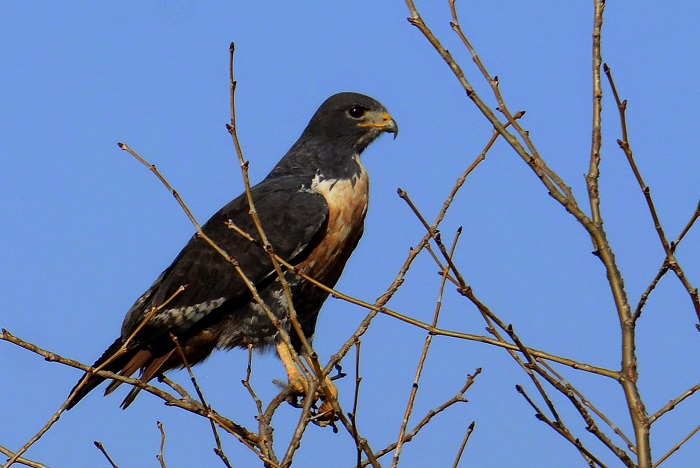
Underberg district, KwaZulu-Natal
Photo by Dave Rimmer
The Jackal Buzzard is most often encountered solitarily or in pairs and rarely in small groups at a rich food source such as termite alate emergences or at carrion. It is not known to undertake any regular seasonal migrations. Any movements are more likely to be nomadic in response to food availability and the dispersal of immature birds.
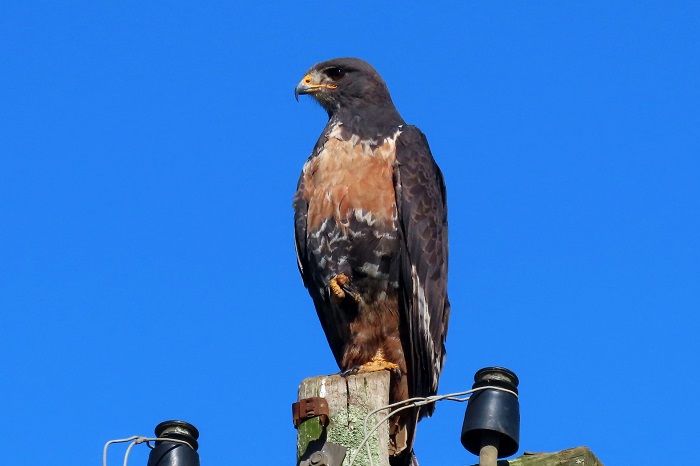
Near Donnybrook, KwaZulu-Natal
Photo by Malcolm Robinson
It often perches prominently on an exposed tree branch, fence post, telephone pole or rock, but is perhaps most often seen in flight. Spends long periods in flight, soaring over valleys and along mountainsides. The Jackal Buzzard often hovers on updrafts in windy conditions, and is able to hang motionless for several minutes. The very broad wings are an adaptation to make specific use of updrafts. In calm conditions, the Jackal Buzzard can hover for short periods while flapping.
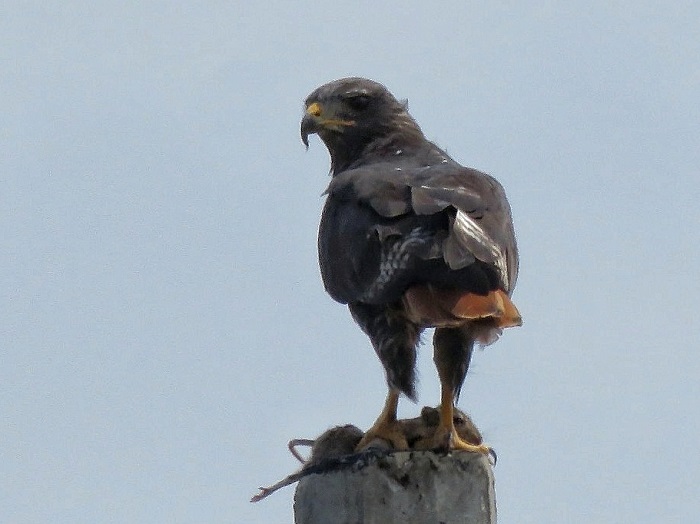
Near Hermanus, Western Cape
Photo by Andries de Vries
Hunts mainly in flight, but also from a prominent perch. Prey is rarely attacked in the air with most prey being captured on the ground after a stoop dive or dropping down from a perch.
The bulk of the diet is made up of small mammals such as rodents, but the Jackal Buzzard is capable of catching larger prey up to the size of hares and young Rock Hyrax. A variety of ground-feeding birds are also taken. Francolins, doves and pigeons are most commonly captured but they can kill birds up to the size of adult korhaans. The Jackal Buzzard also feeds on reptiles like lizards and snakes (including venomous species), and also large insects and spiders.
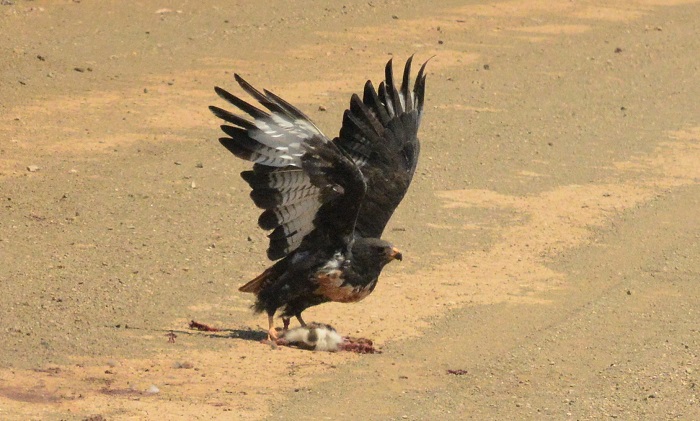
Williston district, Northern Cape
Photo by Ryan Tippett
They are frequent scavengers at carcasses and often consume roadkill, also scavenges sheep placentae during the lambing season. Jackal Buzzards are also known to pirate food from smaller raptors like the Black-shouldered Kite Elanus caeruleua.
The Jackal Buzzard is territorial year-round. It breeds from late winter to early summer throughout its range with most clutches started during August and September.
It is a solitary nester and is generally monogamous, but the population in Lesotho is frequently polyandrous, perhaps due to high population densities. Polyandry has not been recorded elsewhere within the Jackal Buzzard’s range. In polyandrous groups, two males will copulate with one female. They stay together, helping to build the nest and provide the female with food. They also defend the nest from predators and chase off conspecific rivals.
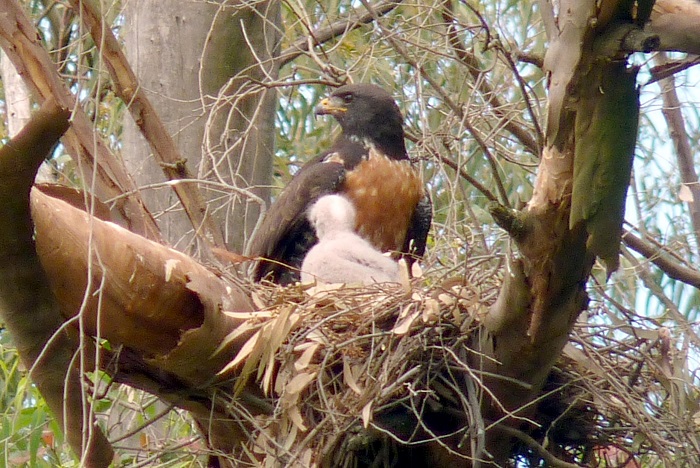
Paarl Bird Sanctuary, Western Cape
Photo by John Fincham
The nest is built or repaired by both sexes and is a bulky platform of sticks up to 2.5 m in diameter. The bowl of the nest is fairly shallow and is mostly lined with leaves, but also with bits of grass and lichen etc. Nests are most often placed on an open cliff ledge and less frequently in trees, and very rarely on man-made structures like pylons or telephone poles. Nests are often used repeatedly for up to five years, or pairs may alternate between different nests, having up to three nests per territory.
Clutches consist of one to three (usually two) eggs. Egg colouration is variable from chalky white and unmarked to heavily blotched, even within a single clutch. The incubation period lasts up to 40 days and is performed by both sexes, but most incubation is done is by the female with the male providing her with food.
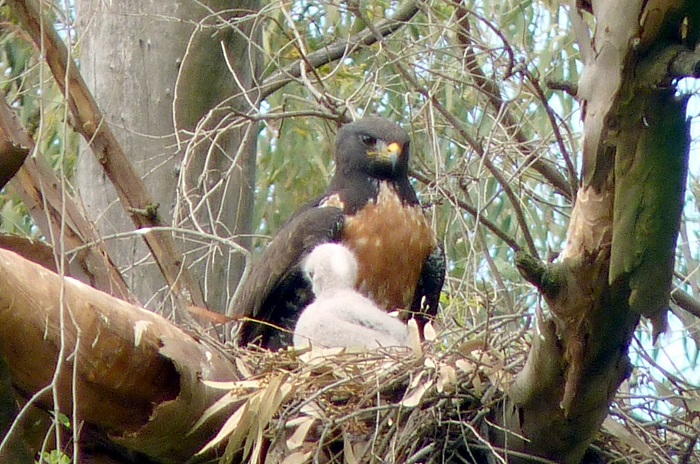
Paarl Bird Sanctuary, Western Cape
Photo by John Fincham
The eggs hatch asynchronously, two to three days apart. This results in large size differences between siblings. The youngest chick may be killed by its larger sibling or gets out-competed and usually dies. The young are fully fledged at around 52 days old but remain dependent on their parents for several more weeks. Adults are often aggressive in defence of the nest, especially the female.
Further Resources
The species text from the First Southern African Bird Atlas Project (SABAP1), 1997, is here.
The use of photographs by Andries de Vries, Attie van Aarde, Dave Rimmer, Desire Darling, Gregg Darling, John Fincham, John Todd, Lance Robinson, Malcolm Robinson and Pamela Kleiman is acknowledged.
Virtual Museum (BirdPix > Search VM > By Scientific or Common Name).
Other common names: Rooiborsjakkalsvoël (Afrikaans); iNhlandlokazi, isiKhobotho (Zulu); Indlandlokazi (Xhosa); Jakhalsbuizerd (Dutch); Buse rounoir (French); Felsenbussard (German); Bútio-de-cauda-vermelha (Portuguese).
List of bird species in this format is available here.
Recommended citation format: Tippett RM 2024. Jackal Buzzard (Buteo rufofuscus). Biodiversity and Development Institute. Available online at https://thebdi.org/2024/07/02/jackal-buzzard-buteo-rufofuscus/
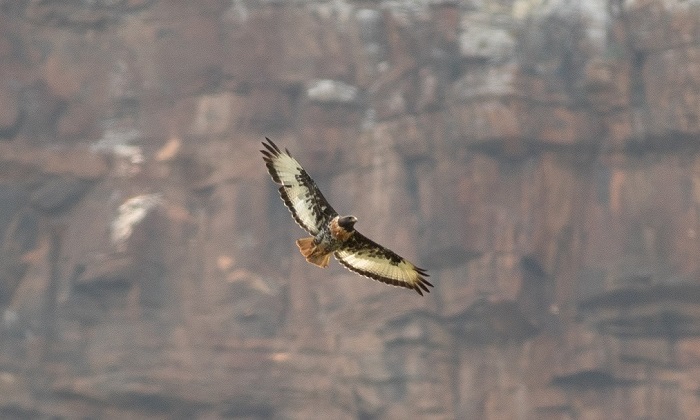
Near Hoedspruit, Mpumalanga
Photo by Lance Robinson

